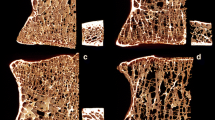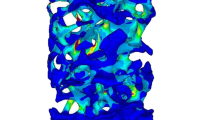Abstract
We previously demonstrated that suppression of bone remodeling allows microdamage to accumulate, thereby leading to reduced bone toughness in dog bone. In this study we evaluated the relationships between bone remodeling at the iliac crest and skeletal activation frequency, microdamage accumulation, or biomechanical properties of lumbar vertebrae using the same dogs to determine whether bone remodeling at the iliac crest can predict damage accumulation and mechanical parameters of the lumbar spine following treatment with antiresorptive agents. Thirty-six female beagles, 1 to 2 years old, were divided into three groups. The control group was treated daily for 12 months with saline vehicle. The remaining two groups were treated daily with oral risedronate at a dose of 0.5 mg/kg/day, or alendronate at 1.0 mg/kg/day orally. The doses of these bisphosphonates were 5 to 6 times the clinical doses approved for treatment of osteoporosis in humans. After sacrifice, the right ilium and L2 vertebra were assigned to histomorphometry. The left ilium and L3 vertebra were used for microdamage analysis. The L4 vertebra was mechanically tested to failure in compression, and bone toughness calculated from the stress–strain curve. There was a strong positive relationship for activation frequency (Ac.f) between ilium and lumbar vertebrae (r2 = 0.82; P < 0.0001). Iliac crest Ac.f underestimates Ac.f in L2, but L2 Ac.f reaches a minimum threshold and does not decline further when iliac crest Ac.f is below 0.10/yr. Microdamage (Cr.S.Dn) accumulation at the ilium was significantly associated with increased microdamage accumulation in the L3 lumbar vertebra (r2 = 0.43, P < 0.0001). The data also show that bisphosphonate treatment increased Cr.S.Dn at a faster rate in L3 than in the iliac crest. Although bisphosphonate treatment decreased bone toughness in L4, this decrease demonstrated no relationship to decreased Ac.f in the ilium. These results clearly indicate that bone remodeling data obtained from iliac crest biopsy could be used to estimate the activation frequency and microdamage burden in the vertebral column.



Similar content being viewed by others
References
Bone HG, Hosking D, Devlogelaer J-P, et al.for the Alendronate Phase III Osteoporosis Treatment Study Group (2004) Ten years’ experience with alendronate for osteoporosis in postmenopausal women. N Engl J Med 350:1189–1199
Harris ST, Watts NB, Genant HK. et al. for the Vertebral Efficacy with Risedronate Therapy (VERT) Study Group (1999) Effects of risedronate treatment on vertebral and non-vertebral fractures in women with postmenopausal osteoporosis. A randomized controlled trial. JAMA 282:1344–1352
Eriksen EF, Melsen F, Sod E, Barton I, Chines A (2002) Effects of long-term risedronate on bone quality and bone turnover in women with postmenopausal osteoporosis. Bone 31:620–625
Chavassieux PM, Arlot ME, Reda C, Wei L, Yates AJ, Meunier PJ (1997) Histomorphometric assessment of the long-term effects of alendronate on bone quality and remodeling in patients with osteoporosis. J Clin Invest 100:1475–1480
Balena R, Toolan BC, Shea M, Markato A, Myers ER, Lee SC, Opas EE, Seedor JG, Klein H, Frankenfield D, Quartuccio H, Fioravanti C, Clair J, Brown E, Hayes WC, Rodan GA (1993) The effects of 2-year treatment with the aminobisphosphonate alendronate on bone metabolism, bone histomorphometry, and bone strength in ovariectomized nonhuman primates. J Clin Invest 92:2577–2586
Boivin G, Chavassieux P, Santora A, Yates J, Meunier P (2000) Alendronate increases bone strength by increasing the mean degree of mineralization of bone tissue in osteoporotic women. Bone 27:687–694
Boivin G, Meunier PJ (2002) Effects of bisphosphonates on matrix mineralization. J Musculoskel Neuron Interact 2:538–543
Roschger P, Rinnerthaler S, Yates J, Rodan G, Fratzl P, Klaushofer K (2001) Alendronate increases degree and uniformity of mineralization in cancellous bone and decreases the porosity in cortical bone of osteoporotic women. Bone 29:185–191
Mashiba T, Hirano T, Turner CH, Forwood MR, Johnston CC, Burr DB (2000) Suppressed bone turnover by bisphosphonates increases microdamage accumulation and reduces some biomechanical properties in dog rib. J Bone Miner Res 15:613–620
Mashiba T, Turner CH, Hirano T, Forwood MR, Johnston CC, Burr DB (2001) The effects of suppressed bone turnover by bisphosphonates on microdamage accumulation and biomechanical properties in clinically relevant skeletal sites of beagles. Bone 28:524–531
Komatsubara S, Mori S, Mashiba T, Ito M, Li J, Kaji Y, Akiyama T, Miyamoto K, Cao Y, Kawanishi J, Norimatsu H (2003) Long-term treatment of incadronate disodium accumulates microdamage but improves the trabecular bone microarchitecture in dog vertebra. J Bone Miner Res 18:512–520
Komatsubara S, Mori S, Mashiba T, Li J, Nonaka K, Kaji Y, Akiyama T, Miyamoto K, Cao Y, Kawanishi J, Norimatsu H (2004) Suppressed bone turnover by long-term bisphosphonate treatment accumulates microdamage but maintains intrinsic material properties in cortical bone of dog rib. J Bone Miner Res 19:999–1005
Burr DB, Hooser M (1995) Alterations to the en bloc basic fuchsin staining protocol for the demonstration of microdamage produced in vivo. Bone 17:431–433
Parfitt AM, Drezner MK, Glorieux FH, Kanis JA, Malluche H, Meunier PJ, Ott SM, Recker RR (1987) Bone histomorphometry: standardizaton of nomenclature, symbols, and units. J Bone Miner Res 2:595–610
Huja SS, Hasan MS, Pidaparti R, Turner CH, Garetto LP, Burr DB (1999) Development of a fluorescent light technique for evaluating microdamage in bone subjected to fatigue loading. J Biomech 32:1243–1249
Turner CH, Burr DB (1993) Basic biomechanical measurements of bone: a tutorial. Bone 14:595–608
Verna C, Melsen B, Melsen F (1999) Differences in static cortical bone remodeling parameters in human mandible and iliac crest. Bone 25:577–583
Thomsen JS, Ebbesen EN, Mosekilde LI (2002) Static histomorphometry of human iliac crest and vertebral trabecular bone: a comparative study. Bone 30:267–274
Alexiades MM, Boachie-Adjei O, Vigorita VJ (1990) Histomorphometric analysis of vertebral and iliac crest bone samples: a comparative study. Spine 15:286–288
Lee TC, Arthur TL, Gibson LJ, Hayes WC (2000) Sequential labeling of microdamage in bone using chelating agents. J Orthop Res 18:322–325
Acknowledgments
The authors gratefully acknowledge Mary Hooser, Diana Jacob, and Thurman Alvey for histologic preparation. This work was supported by NIH grant 2 PO1 AG05793-12. Merck and Co., Inc, and Procter and Gamble Pharmaceuticals, Inc., kindly supplied the bisphosphonates.
Author information
Authors and Affiliations
Corresponding author
Rights and permissions
About this article
Cite this article
Mashiba, T., Hui, S., Turner, C. et al. Bone Remodeling at the Iliac Crest Can Predict the Changes in Remodeling Dynamics, Microdamage Accumulation, and Mechanical Properties in the Lumbar Vertebrae of Dogs. Calcif Tissue Int 77, 180–185 (2005). https://doi.org/10.1007/s00223-005-1295-x
Received:
Accepted:
Published:
Issue Date:
DOI: https://doi.org/10.1007/s00223-005-1295-x




